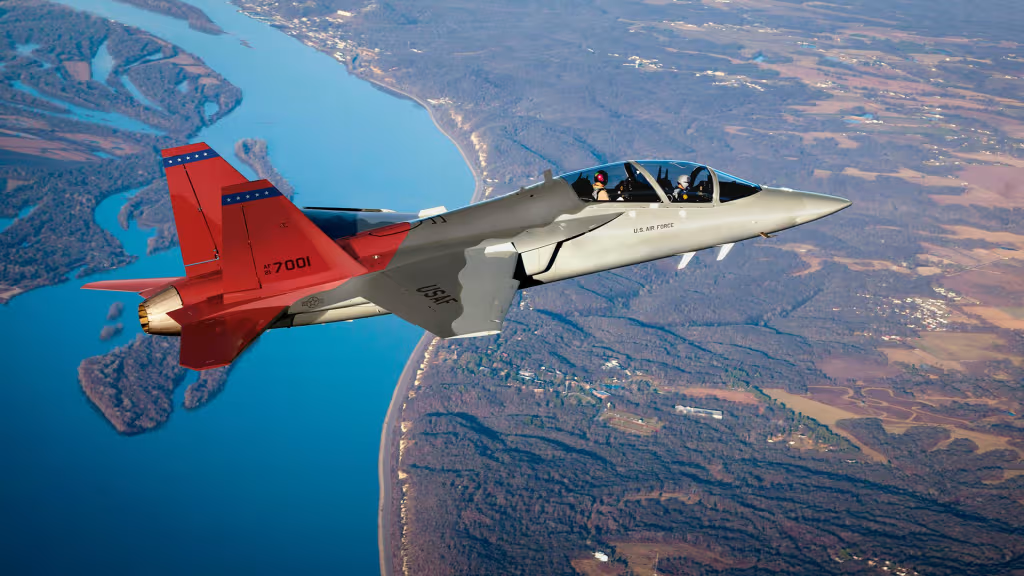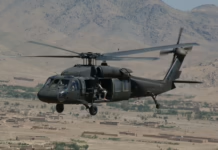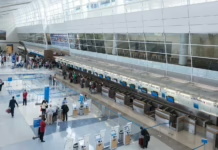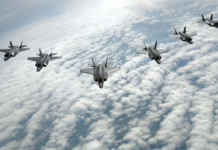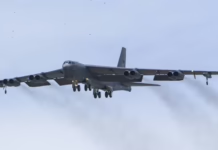The race is on for Britain’s most visible defense deal in years as Boeing and four competitors vie to replace the RAF’s aging Hawks and keep the Red Arrows flying past 2030.
Boeing is ramping up its campaign to sell the T-7A Red Hawk advanced jet trainer to the United Kingdom, positioning the aircraft as the leading candidate to replace the Royal Air Force’s aging fleet of BAE Systems Hawks.
The RAF needs to replace 28 Hawk T2s and the remaining T1-model jets flown by its Red Arrows aerobatic display team, making this one of the UK’s most visible defense acquisitions in the coming years.
Britain’s Ministry of Defence addressed the requirement briefly in its Strategic Defence Review published in early June, recommending that “Hawk T1 and Hawk T2 should be replaced with a cost-effective fast jet trainer.” A formal competition is expected to launch around early 2026, with the MoD already establishing a project team for preliminary work.
Urgency stems from the Red Arrows’ 1970s-era T1s, which officials have said must retire by 2030, and reliability problems with Rolls-Royce-Safran Adour engines that have hurt availability of the newer T2 variant.
Boeing’s T-7A is nearing completion of development and testing before entering service with the U.S. Air Force, which plans to field 351 aircraft to replace obsolete Northrop T-38Cs. Five engineering, manufacturing and development jets have been delivered for testing.
“We recently started production of the first aircraft for the US Air Force, and we will deliver another EMD jet in December to San Antonio, [Texas],” said Dominic Lyons, Boeing UK business development and strategy for air.
The USAF selected Boeing’s design in its T-X competition in September 2018 and is expected to reach a delayed Milestone C production decision in 2026, enabling increased output.
Boeing recently demonstrated the T-7A’s ability to participate in networked training with a ground-based simulator over 130 miles, exceeding USAF performance requirements.
Regarding the UK opportunity, Lyons said Boeing is “waiting to see what that RAF requirement is. Then we will look at how well the T-7 fits.”
“We look forward to more clarity when the Defence Industrial Plan comes out, to understand what the timelines are,” he said. The MoD planning document, potentially arriving in November, is also expected to specify fleet size, currently estimated at 40 to 50 aircraft.
“UK content is obviously going to be key,” Lyons said. “We already have UK content in the jet, and we are in discussions with our existing suppliers.”
Local final assembly is one option for boosting British industrial participation and “makes sense,” he said. Unconfirmed mid-2025 reports suggested BAE had discussed such arrangements with Boeing and its T-7A partner Saab, with BAE’s Warton facility in Lancashire as a possible location.
Lyons pointed to Boeing’s approach on previous UK purchases including the 737-based P-8A maritime patrol aircraft, E-7A Wedgetail airborne early warning platform, and AH-64 Apache helicopters, where British firms joined in-country modification work, long-term support, and global supply chains.
The single-engine Red Hawk uses a GE Aerospace F404 turbofan and Collins Aerospace ACES 5 ejection seats.
“With the platform being designed for a fifth- and sixth-generation environment, and having future flexibility, we think it’s a really good fit for the RAF and a number of other customers,” Lyons said. Boeing projects a potential global market exceeding 1,300 Red Hawks.
The U.S. aircraft faces competition from Leonardo’s M-346, Lockheed Martin and Korea Aerospace Industries’ T-50, Turkish Aerospace’s Hurjet, and British startup Aeralis, which is promoting a modular trainer concept.
A future UK fleet could provide adversary training and companion training for operations with the sixth-generation Tempest fighter being developed through the Global Combat Air Programme with Italy and Japan.

Key Takeaways
- The RAF must replace 28 Hawk T2s and aging T1s used by the Red Arrows, with a formal competition expected around early 2026 for an estimated 40 to 50 aircraft.
- Boeing’s T-7A Red Hawk is in advanced development for the U.S. Air Force, which will field 351 examples, with production recently started.
- UK industrial content and potential local final assembly at BAE’s Warton facility are central to Boeing’s pitch.
- The T-7A faces competition from Leonardo’s M-346, Lockheed Martin/KAI’s T-50, Turkish Aerospace’s Hurjet, and British startup Aeralis.



